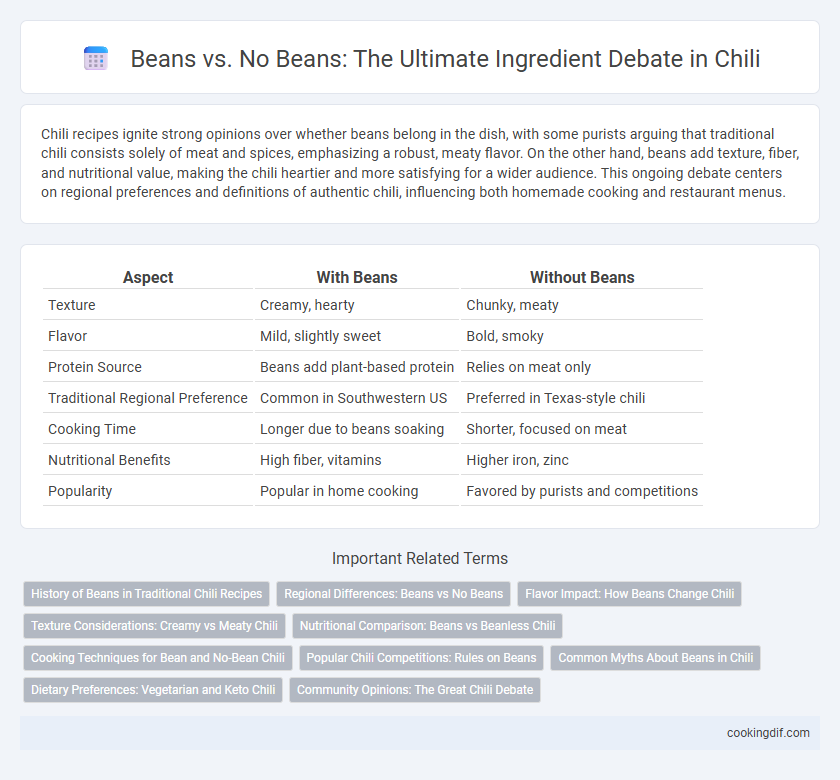Chili recipes ignite strong opinions over whether beans belong in the dish, with some purists arguing that traditional chili consists solely of meat and spices, emphasizing a robust, meaty flavor. On the other hand, beans add texture, fiber, and nutritional value, making the chili heartier and more satisfying for a wider audience. This ongoing debate centers on regional preferences and definitions of authentic chili, influencing both homemade cooking and restaurant menus.
Table of Comparison
| Aspect | With Beans | Without Beans |
|---|---|---|
| Texture | Creamy, hearty | Chunky, meaty |
| Flavor | Mild, slightly sweet | Bold, smoky |
| Protein Source | Beans add plant-based protein | Relies on meat only |
| Traditional Regional Preference | Common in Southwestern US | Preferred in Texas-style chili |
| Cooking Time | Longer due to beans soaking | Shorter, focused on meat |
| Nutritional Benefits | High fiber, vitamins | Higher iron, zinc |
| Popularity | Popular in home cooking | Favored by purists and competitions |
History of Beans in Traditional Chili Recipes
Traditional chili recipes dating back to the 19th century Southwest often excluded beans, emphasizing meat, chili peppers, and spices as the core ingredients. Historical records from Texas cooking contests and old cowboy cookbooks reveal that early chilis, known as "chili con carne," rarely incorporated beans, which were considered a filler rather than an essential component. The inclusion of beans in chili became popularized later in American cuisine, influenced by regional adaptations and vegetarian variations.
Regional Differences: Beans vs No Beans
The debate over beans in chili highlights significant regional differences, with Texas chili traditionally excluding beans to emphasize meat and chili peppers, while other regions like the Midwest and Southwest incorporate beans as a staple ingredient for added texture and flavor. Texan chili, often called "Texas Red," prioritizes chili powder, cumin, and beef, reflecting its history and local tastes, whereas states like New Mexico and Colorado frequently include beans, aligning with their culinary influences and agricultural products. These regional distinctions influence not only recipes but also chili competitions and cultural identity across the United States.
Flavor Impact: How Beans Change Chili
Beans significantly alter chili's flavor profile by adding earthy, creamy notes that balance spicy and smoky ingredients. Without beans, chili emphasizes the robust taste of meats, peppers, and chili spices, creating a richer, more intense flavor experience. Including beans softens textures and integrates a mild sweetness, enhancing overall complexity and mouthfeel.
Texture Considerations: Creamy vs Meaty Chili
Beans in chili contribute a creamy, hearty texture that balances spices and enhances the dish's mouthfeel, creating a rich and satisfying experience. In contrast, bean-free chili emphasizes a meaty texture often achieved with ground beef or chunks of meat, delivering a robust, dense bite favored in Texas-style preparations. Texture considerations largely depend on regional preferences and desired mouthfeel, where beans soften the chili and meat-only versions highlight chewiness and depth.
Nutritional Comparison: Beans vs Beanless Chili
Beans in chili provide a rich source of fiber, protein, and essential minerals such as iron and magnesium, contributing to improved digestion and sustained energy levels. Beanless chili, often higher in animal protein and fat, typically offers more saturated fat and fewer carbohydrates, appealing to low-carb or keto dietary preferences. Nutritional differences influence flavor, texture, and satiety, making the choice between beans or no beans a key factor for health-conscious chili enthusiasts.
Cooking Techniques for Bean and No-Bean Chili
Cooking techniques for chili with beans typically involve simmering dried beans separately after soaking to achieve a tender texture, ensuring they fully absorb spices without becoming mushy. In no-bean chili, chefs often rely on slow-cooking meat and vegetables together longer to develop robust flavors and a hearty consistency. Pressure cooking is a popular method in both versions, speeding up cooking times while melding spices and ingredients uniformly.
Popular Chili Competitions: Rules on Beans
Popular chili competitions often have strict rules regarding the inclusion of beans, with many traditional contests, such as the World's Championship Chili Cook-off, prohibiting beans in the chili to emphasize pure meat and spice flavors. These regulations maintain the contest's authenticity and preserve the original Texas-style chili recipe, which is purely meat-centric. Conversely, some local or regional chili cook-offs allow beans to accommodate diverse tastes, but in top-tier competitions, beans are typically banned to uphold culinary standards.
Common Myths About Beans in Chili
Common myths about beans in chili include the belief that authentic chili must never contain beans and that beans dilute the flavor or make the dish less hearty. Traditional Texas-style chili, often called "chili con carne," typically excludes beans, but many regional recipes embrace beans as a nutritious and flavor-enhancing ingredient. Studies show beans add fiber, protein, and improve texture, making them a valuable addition despite ongoing debates.
Dietary Preferences: Vegetarian and Keto Chili
Vegetarian chili often incorporates beans as a primary protein source, providing essential fiber and nutrients that align with plant-based dietary preferences. Keto chili, in contrast, typically excludes beans due to their high carbohydrate content, favoring meat, cheese, and low-carb vegetables to maintain ketosis. Choosing between beans or no beans significantly impacts the chili's nutritional profile and suitability for these specific diets.
Community Opinions: The Great Chili Debate
The chili community remains divided on the beans versus no beans debate, with purists insisting that traditional chili contains only meat, chili peppers, and spices, emphasizing authenticity rooted in Texan origins. Enthusiasts advocating for beans highlight their nutritional value and ability to add texture and flavor complexity, making chili a heartier and more accessible dish. Online forums and chili cook-offs reveal this passionate discourse persists, reflecting regional preferences and evolving culinary creativity.
Beans vs no beans for ingredient debate Infographic

 cookingdif.com
cookingdif.com